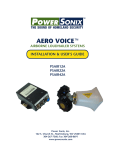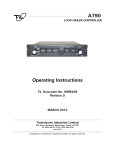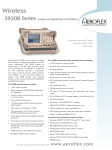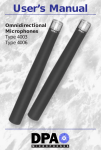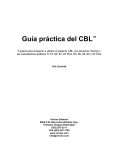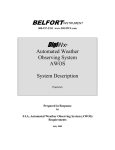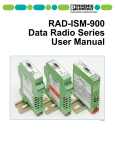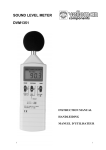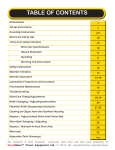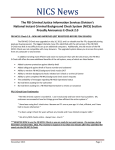Download PSAIR Install Guide
Transcript
INSTALLATION & USER’S GUIDE AIRBORNE LOUDSPEAKER SYSTEMS PSAIR12 PSAIR12+1 PSAIR22 PSAIR42 Power Sonix, Inc. 122 S. Church St., Martinsburg, WV 25401 304-267-7560; Fax 304-268-8691 www.powersonix.com TABLE OF CONTENTS I. Overview Of Aero Voice Public Address Systems Page 1 Installation Options II. Installation Quick Start & Checklist Page 3 Standard Cable Connections Power For The Aero Voice System AC Power From Aircraft DC Power From Aircraft Batteries DC Power From Power Sonix 28 V auxiliary battery pack Audio Controller/Remote Control Unit III. Mounting The Amplified Speaker(s) Page 6 PSAIR12 PSAIR12-1 PSAIR22 PSAIR42 IV. Using the Aero Voice System Page 10 Using the Power Sonix Remote Control Unit Interfacing With Cockpit Audio Controllers Live Microphone Pre-Recorded Messages, Tape/Digital Input Standard Sirens Custom Sirens/Sounds V. Maintenance Page 13 Routine audio testing Battery maintenance & charging VI. Technical Specifications Page 17 VII. Limited 2-Year Warranty RMAs Power Sonix Support Page 18 VIII. Your Dealer/Outfitter Info: ____________________________________________________ Dealer Sales Contact Phone ____________________________________________________ Dealer Customer Service Contact Phone ____________________________________________________ Outfitter/Installation Service Contact Phone ____________________________________________________ 304-267-7560 Power Sonix Factory Support/RMAs Contact © 2003 Power Sonix, Inc. All rights reserved. Page 1 I. Overview Of Aero Voice Public Address Systems Congratulations on your purchase of a Power Sonix public address system. Your aircraft is about to be equipped with the best performing airborne speech projection system in the world today. No other system is as light, as compact, as intelligible, as powerful or as economical as Power Sonix. The Power Sonix Aero Voice Public Address Systems are very modular in nature and very easy to understand. The systems described herein are the 300watt PSAIR12, the 600-watt PSAIR12+1, the 600-watt PSAIR22 and the 1200watt PSAIR42. The Amplified Speaker Array: The core audio components are the horns (bells), the speaker drivers that force the sound through the horns, and the high efficiency Class D amplifier that delivers the audio signal to the drivers. These components are all enclosed in one lightweight, rugged aluminum assembly we call an Amplified Speaker which provides excellent heat sinking. The amplified speaker array is mounted to the aircraft in one of two ways. It can be recessed into the cavity of the fuselage, space permitting. It can also be mounted with metal brackets attached to the undercarriage of the aircraft. Installation Considerations: The first thing that must be determined is where you will place the speaker array on your specific aircraft. Power Sonix recommends that the system be mounted in such a way as to project sound down and away from the aircraft at an angle that is consistent with the aircraft’s mission requirements. At an angle of 45 degrees with the vertical, the peak intensity of the sound beam will hit the ground at an distance from the aircraft that is equal to the altitude of the aircraft (see illustration 1 right). Reducing the angle, reduces the distance that the peak sound intensity will be experienced by those on the ground, away from the aircraft. The distance out from the aircraft of peak intensity is the product of the tangent of the angle times the expected height of the aircraft during broadcast. Illustration 1- 45° angle down and away from aircraft © 2003 Power Sonix, Inc. All rights reserved. Page 2 Once placement has been determined, the next consideration is what will power the PA system. Power can come from DC power supplies already on the aircraft, or a Power Sonix 28V auxiliary battery pack. Stand alone battery packs have limited power and must be recharged. Consult with your dealer and your maintenance chief to determine which is best for your needs. A 45° angle enables the pilot and/or observer to maintain visual contact with the intended audience from a safe hovering position. Don’t be concerned with being too far from your audience. Power Sonix systems have great range. If you are close, you can always reduce the volume. The third major consideration is interfacing the audio signal sources with the Amplified Speaker Assembly. You can use the cockpit headphone mic to deliver speech through the cockpit audio controller to the amplified speaker array. This requires that the cockpit audio controllers have an audio output jack for a PA system (many commercial controllers like Technisonics, Garmin and NAT do). See the operating manual of your controller to see how to integrate your existing equipment with Power Sonix PA Systems. Our engineering dept. is always available to help answer questions regarding this procedure….please feel free to call to expedite your installation. Instead of the cockpit headphones, you can alternatively use a separate noise cancelling microphone (Power Sonix part # PSMIC) and the Power Sonix Remote Control Unit (PSRCU). The RCU is required in any instance where the existing cockpit audio controller does not support a public address system. In that case, it is the audio controller for the PA and has its own on/off switch. The advantage to having the RCU, in addition to a supporting cockpit audio controller, is the convenience to do things quickly and easily in the air including; 1.) having someone without a headset speak into the system with a hand-held mic, 2.) the ability to plug a cassette tape, CD player or DVD player with pre-recorded messages/sounds into the RCU which delivers the digital signal to the amplified speaker array. If you intend to do these things with your existing audio controller, make sure that it has the necessary wiring interconnects available and consult your equipment user’s manual. The finish on the Remote Control Unit is anodized black. The speaker assemblies come standard in a powder-coated white or olive drab finish. © 2003 Power Sonix, Inc. All rights reserved. Page 3 II. Installation Quick Start Standard Cable Connections There are only a few connections that have to be made to make your Power Sonix system operational. All the wiring inside the amplified speaker array is factory installed and tested. There is no need to access the internal assembly of the amplified speaker array. Once the speaker array mounting position is determined, measurements of the distance from the amplified speaker to the power source and to the audio controller (either the cockpit audio controller or the Power Sonix Remote Control Unit) are made. Standard cables are provided in 10' and 15' lengths and should meet most requirements. If standard cables are not long enough, either Power Somnix or your aircraft maintenance facility can make custom cables. Illustration 2 depicts the PSAIR cabling requirements. Illustration 3 below shows a diagram of the the cable used to connect the amplified speaker array to either the cockpit audio controller or the Power Sonix Remote Control Unit (PSRCU). The amplified speaker array (PSAIR42 shown), connects to a power supply and to an audio controller. Power is usually supplied from existing aircraft batteries (must be rated 28v) or an auxiliary battery like the Power Sonix PSBAT28 shown left. The mic in the cockpit headset can be used if connecting to the cockpit audio controller. A separate mic is used when connecting to the Power Sonix remote control (PSRCU). The loudspeaker system is controlled by either the cockpit audio controller (if capable), or by the Power Sonix Remote Control Unit (PSRCU) shown to the right. AC Battery Charger (PSACDC) plugs directly into “Power-In” connector on 28V battery (PSBAT28) during routine maintenance. The REC input connection allows prerecorded message to be played from cassettes or CD players. Illustration 2 - Basic System Connections © 2003 Power Sonix, Inc. All rights reserved. Page 4 Illustration 3 - Audio Remote Control Cable PSCBL-RCU Used when connecting PSAIR amplified speaker array to the Power Sonix Remote Control Unit, PSRCU Illustration 4 - Signal Cable PSCBL-SIG Used to connect PSAIR amplified speaker arrays to the Cockpit Audio Controller Illustration 5 - Auxilary Speaker cable PSCBL-AUX Used to connect audio from the master PSAIR12 amplified speaker array to the Auxilary +1 Speaker assembly The PSAIR12+1 has an additional cabling requirement. An audio cable connects the amplified speaker and the second speaker. The second speaker can be mounted directly next to the amplified speaker or it can be mounted on the other side of the undercarriage to project sound in a completely different direction/area. On the rear panel of each PSAIR amplified speaker array, there is an Activation Switch (pull up to toggle). In the “ON” position, the system is ready to be controlled by the cockpit audio controller. In the “OFF” position, the unit is controlled by the Power Sonix Remote Control Unit (PSRCU). Additionally, when not using the PSRCU, a low impedance source (150 ohm, milli-volt level signal) can be applied to the pre-amp input. A 5mv rms signal will produce full power rating at the speaker output. © 2003 Power Sonix, Inc. All rights reserved. Illustration 5 Activation Switch Page 5 Power Connections For The Aero Voice System The source power source MUST be 24-32 VDC (i,e, nominal 28 V aircraft supply). NOTE: THESE SYSTEMS ARE NOT DESIGNED TO OPERATE WITH MORE THAN 32 VOLTS. Using AIRCRAFT DC POWER - This requires Power Sonix power cable PSCBL-DC in the length appropriate for your aircraft. No power supply converter is needed when utilizing DC power. Using AUXILIARY BATTERY POWER - This requires a Power Sonix 28 Volt NiCad battery pack (PSBAT28 or PSBAT28SCU) and Power Sonix power cable PSCBL-BAT in the length appropriate for your aircraft. Please consult with your dealer, outfitter and maintenance crew chief to determine the power configuration that best meets your needs on your aircraft. The load of other systems that could ever be used simultaneously with the PA must be taken into account when considering using existing AC or DC power supplies on board your aircraft. Please contact Power Sonix Engineering. Dept. for any questions regarding any installation issues. Illustration 6B - Power Cable Connections For PSAIR12 & PSAIR12+1 © 2003 Power Sonix, Inc. All rights reserved. Page 6 Illustration 6B - Power Cable Connections For PSAIR22 & PSAIR42 III. Mounting Your Aero Voice Public Address Systems General Considerations Your aircraft is unique. The systems and equipment installed inside and outside the fuselage are likely different from other aircraft, even within your own fleet. One user may want the system attached to the fuselage, one may want it it attached to the struts, another may want it recessed into the fuselage. A searchlight may already be a in position you’d like to use. The size of strut bars varies widely from lightweight to heavyweight helicopters. Because there are so many variables, brackets must be fabricated to meet the specific needs of you aircraft. Your Power Sonix dealer and your helicopter outfitter will work with you to determine exactly where the system should go on your aircraft and will fabricate the metalwork to form a bracket for permanent installation. Power Sonix provides the technical specifications for the measurements of the mounting hard points on each of our amplified speaker arrays. With this information, the service engineers are able to devise a bracket to meet your needs. © 2003 Power Sonix, Inc. All rights reserved. Page 7 Mounting Hard Points PSAIR12 AND PSAIR12+1 The PSAIR 12 is a single bell system and our smallest Airborne model. The small footprint offers installers great flexibility in determining the placement on the airframe or fuselage. Illustration 6 below shows the location of the 832NC threaded hard points, 4 on each side of the PSAIR12. These measurements also apply to the auxiliary speaker assembly of a PSAIR12+1 and for attaching a bracket to the short side of the PSAIR22. 6.500" 2.500" 4.500" 6.750" PSAIR12 OR PSAIR12+1 Hard Points 2.000" 3.500" 8-32 NC Hard Points 4 On Each Side 2.000" 3.500" 2.000" 7.625" Illustration 7 - Mounting Hard Points For PSAIR12 or PSAIR12+1 Illustration 8 - Mounting Hard Points For PSAIR22 9.50" 3.000" 3.000" 9.500" 6.500" 1.750" 1.250" 1.750" 9.750" Eight 8-32 NC Hard Points on each side of speaker assembly 1.750" 4.500" 1.750" 1.500" 1.500" 1.500" 4.750" 7.625" © 2003 Power Sonix, Inc. All rights reserved. 8.250" PSAIR22 Hard Points 1.250" The PSAIR22 is a 2-bell system that has 600 watts of power. The hard points on the enclosure are located on the short sides of the enclosure. This enable the assembly to be mounted and oriented in such a way as to provide a horizontally broader area of sound dispersion. The eight hard points ensure a solid and stable attchment to the mounting bracket and aircraft. 1.250" PSAIR22 1.00" Page 8 PSAIR42 PSAIR42 Hard Points 15.000" Two 1/2 - 13 NC Hard Points on each side of speaker assembly 4.344" 15.250" 6.312 4.344" The PSAIR42 is a 4- bell system and the most powerful of our standard Airborne models. This system can be attached to airframe, struts or recessed into the fuselage. Illustration 6 below shows the location of the 1/2"-13NC threaded mounting hard points on the side of the PSAIR42. The holes are 6.312" apart on center. From the center of the hard point, there is a distance of 5.00" to the outer edge of the assembly back cover. 5.000" 2.50" 7.625" Illustration 9 - Mounting Hard Points For Mounting PSAIR42 © 2003 Power Sonix, Inc. All rights reserved. Page 9 Angle of Voice/Sound Projection If most communications are made from a level hovering position relatively close to the target audience, a 45° mounting position down and away from the fuselage is recommended to direct the sound beam to an area outside the rotor blast. Speaker angles may need to be adjusted based on mission objectives. The sound beam is directional. The beam’s intensity falls off to 50% at 30° degrees to either side of the direct line of sight of the center beam Using One PA System For Multiple Helicopters If you have multiple aircraft that you want to use a single Power Sonix loudspeaker system on, you can do it. First, a permanent bracket would be installed on each helicopter. This may require variations of the bracket. However, the part of the bracket that mounts to the amplified speaker assembly hard points would be identical on all brackets. You would also need to pre-wire each helicopter with the power and audio remote control cables needed for each aircraft. When not in use, they would need to be secured. Once each aircraft is outfitted, the amplified speaker array can be moved from one aircraft to another. It is important to note that an FAA field test (Form 337) is required for each aircraft that you are modifying since this approval procedure is serial number specific. (See NOTE above.) FAA Field Inspection Once installed, an FAA Form 337 Field Test must be conducted to get your modification approved. There is no cost from the FAA for this test. After you schedule the inspection with your nearest FAA Field Office, you just have to make the aircraft and a pilot available. This is standard procedure and any FAA licensed maintenance or overhaul facility will take care of this for you. (Note: Military and State and Local Government Law Enforcement agencies may not be subject to the N Classification modification requirements of the FAA. However, it is always a good practice to thoroughly test the aircraft after any major modification, including the addition of externally mounted loudspeakers, searchlights, cameras etc.). © 2003 Power Sonix, Inc. All rights reserved. Page 10 IV. Using the Power Sonix Aero Voice System Operating the voice Amplifier system is relatively simple. However, certain techniques, some of which will be gained by experience, should be developed to obtain the most favorable results. The system possesses the capability of high quality voice transmission over long distances and for long periods of time. However, effective utilization of these features depends, to a great extent, upon proper operating procedures. To successfully project the voice over long distances, it is necessary to develop a microphone technique different from the normal conversational manner. Talk clearly and distinctly, separating each word with noticeable pauses. Keep the voice volume high with the top of the microphone touching the upper lip so that the speech is as close to the microphone as possible. A normal (medium pitched) voice is more intelligible and carries farther than a bass voice. Microphone Options And Operation Users may utilize an existing cockpit headset microphone connected to a cockpit audio controller provided that the controller has appropriate connectors to receive the cable from the Power Sonix amplified speaker assembly . Alternatively, users can employ the Power Sonix/Shure, noise-cancelling microphone (PSMIC) by connecting it to either a mic jack on the cockpit audio controller or to the mic jack on the Power Sonix Remote Control Unit (PSRCU). On the PSMIC, the "Gain" control is adjusted clockwise from OFF. If troubled with feedback it may be necessary to reduce the input "Gain" control or preferably, improve the sound shielding of the microphone position. This can be done by closing windows and eliminating a direct audio air medium back to the microphone from the speakers. © 2003 Power Sonix, Inc. All rights reserved. Page 11 Remote Control Unit The Power Sonix Remote Control Unit (PSRCU) can independently control all aspects of the loudspeaker system. This component is required if your cockpit audio controller does not have the capacity to interface with the Aero Voice system and its connecting cables. Please contact Power Sonix ([email protected]) to determine the necessary wiring connections to use a specific cockpit controller. We will need a wiring diagram of the controller output connector and its electrical specifications to interface the two systems. The Remote has an audio input jack for a microphone and one for an audio recording devise such as a tape cassette recorder, CD player or DVD player. These devises can deliver standardized and studio quality pre-recorded messages to the Aero Voice loudspeakers. The large connector on top of the Remote is used to connect it to the amplified speaker array (using cable PSCBL-RCU). Power Sonix systems are not intended to play hi-fidelity music. If the recorded sound is music, it is advisable to operate at a reduced "Gain" control setting. Failure to reduce the gain setting may cause excessive power to be dissipated in the speaker units and result in failure of the speaker voice coils due PIN FUNCTION to overheating. The red Push-To-Test (PTT) power light will show that DC power is connected when depressed. It is also an indicator that the system is on when the power toggle switch is turned on. The ten element bar graph shows the level of power being delivered to the speakers from the amplifier. It also has one element lit when no signal is applied and serves as a secondary power on indicator. © 2003 Power Sonix, Inc. All rights reserved. A B C D E F G SWITCHED POWER GROUND + VOLTAGE - SIGNAL + SIGNAL RELAY METER SIG. (0-5V) Remote Control Unit PSRCU PIN Function Chart Page 12 The "Gain" dial indicates the power or volume that the speakers are putting out. For safety reasons, it is best to keep the "Gain" in the "Off" position until you are ready to begin your broadcast. If any feedback occurs, it may be necessary to reduce the input "Gain" control or preferably, improve the sound shielding of the microphone. When a siren sound is needed, a separate siren switch is pushed to activate the sound. Press the switch for the sound (siren wail or trill) you wish to broadcast. Pressing the switch while the siren is broadcasting will turn the siren OFF again. Custom siren sounds can be permanently encoded onto a chip inside the Remote Control Unit for a moderate feel. Each custom sound would replace one of the two standard sirens factory installed. This requires sending the PSRCU unit back to Power Sonix for modification along with a digital recording of the sound you wish to use and, if applicable, a decision on which of the existing sirens you want to replace. AC Battery Charger (PSACCHARGE) © 2003 Power Sonix, Inc. All rights reserved. 28V Battery with State of Charge Unit (PSBAT28SCU) Page 13 Maintenance Routine testing of the loudspeaker equipment should be incorporated into the maintenance or flight-ready checklist. Simple troubleshooting can be conducted in the hanger. Power Sonix Tech Support is always available via phone to assist in the installation and troubleshooting. Any major issues with your equipment would require an RMA for factory servicing. Amplifier Checks - When normal operation is impaired the following possibilities should be checked: a. Press the “Press To Test” (PTT) light to make sure power is available (if using the Power Sonix Remote Control Unit PSRCU) b. Check the input Polarity of the DC supply. Make sure sufficient voltage is available, and that excessive voltage is not applied; (no greater than 32 volts DC) c. Check any cable for shorts or opens. DC resistance on the drivers is approx 2.5 ohms. d. Battery may not be properly connected. The PTT light does not indicate until pressed. d. Power Switch off. PTT light does not indicate until pressed. e. No DC power to Remote Control Unit. PTT light does not indicate normally or when pressed. f. Make sure the signal source is not shorted or connected to any noise source. g. The Amplifier may be faulty. This will require factory maintenance. The amplifier will automatically reset when reapplying power after a fault is found. Power Supply Checks - The battery voltage should measure between 24 and 32 volts unloaded and l/2 to l volt lower under load. Check the proper polarity. Loudspeaker And Cable Checks - Testing of loudspeakers and cables may, to some extent, be done visually. All connections should be free from dirt, moisture and open or shorted conditions. All receptacle threads should be thoroughly engaged. A continuity meter may be used to establish the state and correctness of wiring. An ohmmeter touched across the loudspeaker inputs should cause an audible click sound. Precautions In Maintenance - To avoid serious damage to system components while undergoing troubleshooting or testing, please read these warnings carefully before initiating test procedures. © 2003 Power Sonix, Inc. All rights reserved. Page 14 CAUTION: Always pre-test the amplified speaker with 20 volts DC supply voltage when its condition is doubtful. This precaution will minimize the danger to expensive components. CAUTION: Do not operate the system from an inadequate power supply or a shop supply, giving rise to high voltage transients. CAUTION: Careless poking around with a screwdriver in a live circuit can cause extensive damage. Even momentary large currents or voltages through power FETs can permanently damage the unit. CAUTION: A grounded test probe from a AC powered meter or Scope placed across the output will short the output to ground and trigger the shutdown circuitry. All test equipment should be isolated from ground potential. Amplified Speaker Maintenance - The amplified speaker should be kept clean and free from exposure to static charge accumulation and debris. There are no serviceable procedures to be used in repairing the Class D amplifier inside the assembly. CAUTION: Tampering with the amplifier board itself will void your warranty. Field access to the amplified speaker assembly can only be made with factory authorization. Unauthorized access voids the warranty. Mounting Bracket Maintenance - Consult your dealer or service provider who installed your Power Sonix equipment regarding any maintenance procedures pertaining to the mounting bracketry. Specifications for 600-watt, Class D Amplifiers and Pre-Amp Specification Distance @ 70db SPL @ 1m Number of Speakers Power Output Pre-Amp Frequency Response Harmonic Distortion Sensitivity DC Voltage Range Peak Current Shutdown PSAIR12 PSAIR12+1 PSAIR22 PSAIR42 .75 miles .75 miles 1.25 miles 2.0 miles 145 dB 145 dB/pr 148 dB 151dB 1 2 Separate 2 4 300W RMS 600W RMS 600W RMS 1200W RMS 150 Ohm Input Impedance (All Systems) 400 to 4500 Hertz (All Systems) 1% (All Systems) 1 Volt RMS @ 1 KHertz (All Systems) 24-32 Volts DC 35 Amperes RMS © 2003 Power Sonix, Inc. All rights reserved. Page 15 Speaker Driver Maintenance - No maintenance of the speaker driver is required. Should a driver fail while under warranty, please return it to Power Sonix for replacement. If out of warranty, please call Power Sonix to purchase a new driver. Speaker Driver Replacement A loudspeaker driver may fail due to several causes. (1) The coil or its terminals may short to the mounting and cause the amplifier to cut off. This is apparent (once the leads of the suspected driver are separated from other drivers of the speaker assembly) by a continuity test from a lead to the chassis ground. (2) A voice coil short (not likely) showing zero ohms between voice coil leads will also cause the amplifier to cut off. (3) A voice coil open-circuit (more likely) will show with an ohmmeter check between leads. No sound will result when the ohmmeter is applied. (4) A noisy driver results when the voice coil rubs against the magnetic gap. Noise can best be localized to a single driver unit by connecting each unit singly and energizing each with the amplifier output. To access the drivers: 1.) Make sure your are adequately grounded. 2.) Unscrew the lid to the rear enclosure 2.) Remove the re-entrant tip from the front of the horn section of the speaker (unscrew counter-clockwise). 3.) The faulty driver is then freed by removing the four 1/4 - 20 mounting screws now exposed. Check each driver for a short or an “open”. A short is evidenced by less than 1 ohm resistance and an “open” by any resistance over 3 ohms. The correct reading should be approximately 2.5 ohms. Shorts from the wiring to the chassis can be checked with a ohm meter, one lead on the chassis and the other touching the separated output lines connected to the speaker drivers lines which should not show a zero ohm resistance to the case. There is no need to perform impedance tests. Install the replacement driver by accessing the enclosure using the above procedure. Connect the leads to the terminals at the rear. Observe the color code to preserve the speaker polarity. IMPORTANT - RED TO #1 TERMINAL, BLACK TO #2 TERMINAL © 2003 Power Sonix, Inc. All rights reserved. Page 16 Resetting Protective Circuit The Power Sonix 600 Watt Class D amplifier is designed with self-protecting circuitry to interrupt the operation whenever unusual conditions exist which might endanger the amplifier components. Such a condition might be an excessive load current or an output short. Once the protective circuit is activated, the flow of power is stopped in the affected channel and no further operation is possible without corrective action. If the trouble was due to a temporary or transitory cause, operation may be resumed by simply turning the power switch OFF, wait 5 seconds to allow the internal circuitry to reset, then turn back to ON. Summary of Care And Precautions The Power FETs of this system are subject to damage when exposed to excessive heat, voltage, and current for even short periods of time. The design incorporates a protective circuit for each channel which disables the amplifier, or channel affected, when safe operating currents are exceeded. Operation of a protective circuit is indicated by the extinguishing of the amplifier power lamp. The protective circuits are adequate in most instances; however, they are also subject to damage when extreme or sustained stresses are allowed to exist. Careful monitoring is therefore necessary when operating under unusual environmental extremes. Precautions should be taken to maintain temperature within recommended limits (see Par. 4, Section l). Other damaging conditions are: excessive battery charging voltage; short circuits within the system; transmission of compressed, high level music resulting in continuous high-level power generation. © 2003 Power Sonix, Inc. All rights reserved. Page 17 Technical Specifications: 1. SUPPLY VOLTAGE: These integrated systems are designed to operate on a nominal 28 volt DC aircraft voltage. Operation at higher voltages may cause speaker damage as they are designed to deliver 150 watts each at the 28 volt DC rating. Higher voltage operation will therefore cause overheating and possible speaker failure. Do not operate Power Sonix loudspeakers at voltages over 32 Volts DC. 2. FREQUENCY RESPONSE: The amplifier response is flat within 3 dB over the frequency range of 400 to 4500 HZ. The amplifier filters input signals with 4th order low and high pass filters. This band pass window is designed for maximum voice intelligibility. 3. HARMONIC DISTORTION: The THD is less than 1% at a frequency of 1 KHz at low input signal levels. 4. SENSITIVITY: The amplifier will deliver 600 watts of power into a resistive 1 ohm load at a 28 volt DC supply when a signal of 1 volt rms @ 1 KHz is applied to the signal input, pins D and E on the remote connector. 5. POWER OUTPUT/SPL: The amplifier output power is a function of the number of speaker drivers used. The maximum power output is 600 watts, capable of driving 4 speaker drivers rated at 150 watts each. The SPL rating at 600 watts of power is 148 dB at 1 meter, sufficient to project voice signals in excess of 1 mile in a specific direction from the air to the ground. 6. CURRENT DRAW: When delivering the full 600 watts to the speaker load, the amplifier will draw approximately 24 amps DC. Each 150 watt speaker driver uses 6 amps max for operation at 28 volts DC. The protective circuit is designed to shut down operation if the rms current exceeds 35 amps DC. If shut down occurs, turn off the power to the unit, wait 5 seconds, re-apply power. 7. TEMPERATURE RANGE: The amplifier will operate between -40 to 150F ambient (-40 to 65 C). 8. ALTITUDE: The systems are capable of operating at any altitude up to 15,000 feet. 9. PROTECTIVE CIRCUIT: As stated above, the systems are protected on the high voltage side against shorts. If the rms current exceeds 35 amps, the amplifier will turn off to protect itself. To reset the amplifier, turn it off for several seconds and then re-apply power. © 2003 Power Sonix, Inc. All rights reserved. Page 18 Warranty Power Sonix, Inc. offers a Two-Year Limited Warranty on all parts and assemblies against defects. This warranty does not include damage caused by negligence, misuse of the equipment, gunfire, exposure to excessive heat or fire, accidents or acts of God.The warranty is void if there is unauthorized access to the amplified speaker assembly or electronic component. Any repair or service required under this warranty will be authorized via an RMA if an initial telephone tech support call cannot remedy the situation in the field. The Warranty Card must be filled out and submitted to Power Sonix to effect your warranty. The installation service provider should record the date and place of installation on the Warranty Card. The warranty period begins when the equipment is installed. Return Merchandise Authorization To send equipment back for warranty or out-of-warranty service, please call Power Sonix to obtain an Return Merchandise Authorization, RMA. The RMA number provided MUST BE clearly marked on the shipping label. We will not accept equipment that does not have an RMA. Ship equipment to: Power Sonix, Inc. 122 South Church St. Martinsburg, WV 25401 USA RMA# (Telephone number for Shipper’s Reference (614) 267-7560) Contact Information For sales, customer service or technical assistance, call us at our headquarters in Martinsburg, WV, USA at 614-267-7560. Our Fax number is 304-267-8691. Emails for company departments are as follows: Sales Customer Service Technical Support [email protected] [email protected] [email protected] © 2003 Power Sonix, Inc. All rights reserved.




















